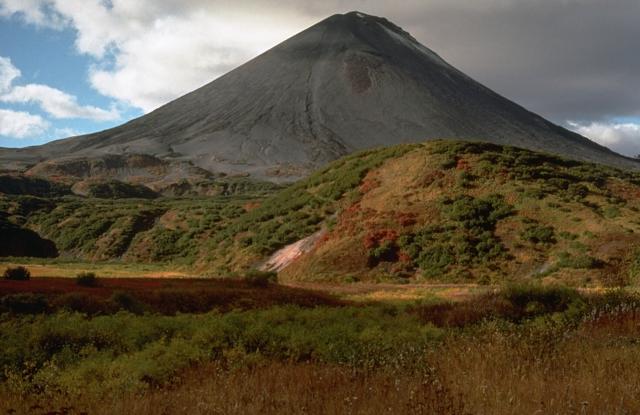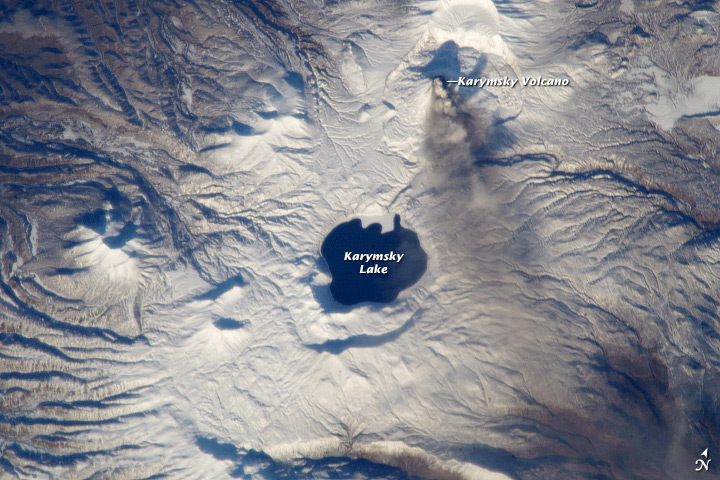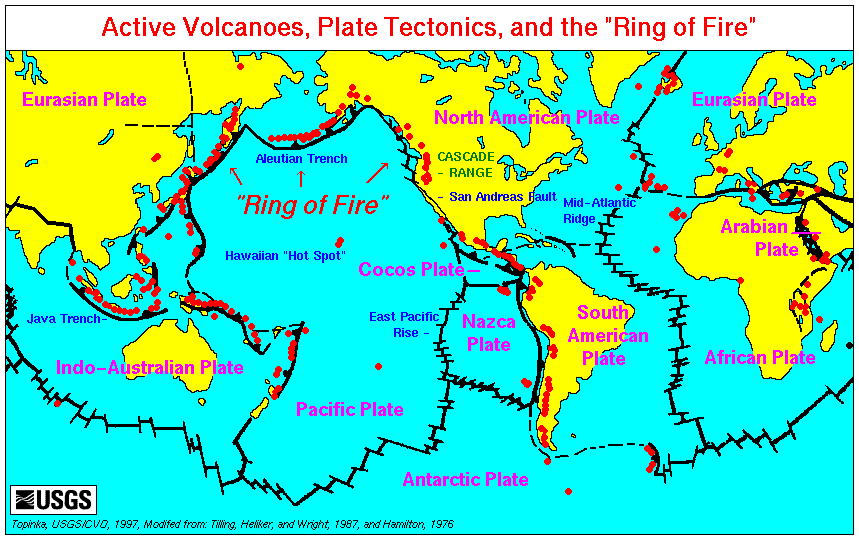|
Akademia Nauk (volcano)
Akademia Nauk ( - ''Academy of Sciences'') is a volcano located in the southern part of Kamchatka Peninsula, Russia, next to the stratovolcano of Karymsky. The volcano is filled with a few caldera A caldera ( ) is a large cauldron-like hollow that forms shortly after the emptying of a magma chamber in a volcanic eruption. An eruption that ejects large volumes of magma over a short period of time can cause significant detriment to the str ...s, and the most notable one is known as Karymsky Lake (named after Karyms). The volcano is named after the ''Росси́йская Акаде́мия Нау́к'', the Russian (Soviet) Academy of Sciences. It last erupted on 2–3 January 1996, which continued through the end of April. 1996 eruption On 2 January 1996, Akademia Nauk erupted. Eruptive pulses from the bottom of Karymsky Lake ejected steam and ash columns in the air every five to six hours for the 18 hours that followed, releasing approximately 30 to 40 million tons of ... [...More Info...] [...Related Items...] OR: [Wikipedia] [Google] [Baidu] |
Karymsky (volcano)
Karymsky (, ''Karymskaya sopka'') is an active stratovolcano on the Kamchatka Peninsula, Russia. It and Shiveluch are Kamchatka's largest, most active and most continuously erupting volcanoes, as well as one of the most active on the planet. It is named after the Karyms, an ethnic group in Russia. Description Karymsky is a symmetrical stratovolcano rising within a 5-km-wide caldera that formed during the early Holocene. Much of the cone is mantled by lava flows less than 200 years old. Historical eruptions have been vulcanian or vulcanian- strombolian with moderate explosive activity and occasional lava flows from the summit crater. There is currently an ongoing cycle of non-stop eruption occurring, and is the peninsula's most active, and reliable volcano, which has been erupting continuously since 1996. Eruptions An ongoing cycle of almost continuous eruption has been occurring since 1996. See also * List of volcanoes in Russia This is a list of active and ext ... [...More Info...] [...Related Items...] OR: [Wikipedia] [Google] [Baidu] |
Karymsky Lake
Karymsky Lake () is a volcanic crater lake located in the Akademia Nauk volcano on the Kamchatka Peninsula, Russia. On midnight of 2 January 1996, Akademia Nauk and Karymsky Lake erupted. Eruptive pulses from the bottom of Karymsky Lake ejected steam and ash columns in the air every five to six hours for the 18 hours that followed, releasing approximately 30 to 40 million tons of highly acidic pyroclastic material in the air, tsunamis up to 20 meters (65 feet) also occurred. A new volcanic crater was also formed on the mountain's north coast. Much of the material, which was rich in sodium, sulfates, calcium, and magnesium, collapsed back into Lake Karymsky, changing its pH from 7.5 (neutral) to 3.2 (moderately acidic). The chemical change, plus a change in temperature, killed most of the life in the lake. The pH of Lake Karymsky had returned to neutral (7.54) by 2012, but it was still three times saltier than prior to the 1996 eruption. References Lakes of Kamchatka Krai V ... [...More Info...] [...Related Items...] OR: [Wikipedia] [Google] [Baidu] |
Pleistocene Volcanoes
The Pleistocene ( ; referred to colloquially as the ''Ice Age'') is the geological epoch that lasted from to 11,700 years ago, spanning the Earth's most recent period of repeated glaciations. Before a change was finally confirmed in 2009 by the International Union of Geological Sciences, the cutoff of the Pleistocene and the preceding Pliocene was regarded as being 1.806 million years Before Present (BP). Publications from earlier years may use either definition of the period. The end of the Pleistocene corresponds with the end of the last glacial period and also with the end of the Paleolithic age used in archaeology. The name is a combination of Ancient Greek () 'most' and (; Latinized as ) 'new'. The aridification and cooling trends of the preceding Neogene were continued in the Pleistocene. The climate was strongly variable depending on the glacial cycle, oscillating between cold glacial periods and warmer interglacials, with the sea levels being up to lower th ... [...More Info...] [...Related Items...] OR: [Wikipedia] [Google] [Baidu] |
Calderas Of Russia
A caldera ( ) is a large cauldron-like hollow that forms shortly after the emptying of a magma chamber in a volcanic eruption. An eruption that ejects large volumes of magma over a short period of time can cause significant detriment to the structural integrity of such a chamber, greatly diminishing its capacity to support its own roof and any substrate or rock resting above. The ground surface then collapses into the emptied or partially emptied magma chamber, leaving a large depression at the surface (from one to dozens of kilometers in diameter). Although sometimes described as a crater, the feature is actually a type of sinkhole, as it is formed through subsidence and collapse rather than an explosion or impact. Compared to the thousands of volcanic eruptions that occur over the course of a century, the formation of a caldera is a rare event, occurring only a few times within a given window of 100 years. Only eight caldera-forming collapses are known to have occurred between ... [...More Info...] [...Related Items...] OR: [Wikipedia] [Google] [Baidu] |
Mountains Of The Kamchatka Peninsula
A mountain is an elevated portion of the Earth's crust, generally with steep sides that show significant exposed bedrock. Although definitions vary, a mountain may differ from a plateau in having a limited summit area, and is usually higher than a hill, typically rising at least above the surrounding land. A few mountains are isolated summits, but most occur in mountain ranges. Mountains are formed through tectonic forces, erosion, or volcanism, which act on time scales of up to tens of millions of years. Once mountain building ceases, mountains are slowly leveled through the action of weathering, through slumping and other forms of mass wasting, as well as through erosion by rivers and glaciers. High elevations on mountains produce colder climates than at sea level at similar latitude. These colder climates strongly affect the ecosystems of mountains: different elevations have different plants and animals. Because of the less hospitable terrain and climate, mountains t ... [...More Info...] [...Related Items...] OR: [Wikipedia] [Google] [Baidu] |
Volcanoes Of The Kamchatka Peninsula
A volcano is commonly defined as a vent or fissure in the Crust (geology), crust of a planetary-mass object, such as Earth, that allows hot lava, volcanic ash, and volcanic gas, gases to escape from a magma chamber below the surface. On Earth, volcanoes are most often found where list of tectonic plates, tectonic plates are divergent boundary, diverging or convergent boundary, converging, and because most of Earth's plate boundaries are underwater, most volcanoes are found underwater. For example, a mid-ocean ridge, such as the Mid-Atlantic Ridge, has volcanoes caused by divergent tectonic plates whereas the Pacific Ring of Fire has volcanoes caused by convergent tectonic plates. Volcanoes resulting from divergent tectonic activity are usually non-explosive whereas those resulting from convergent tectonic activity cause violent eruptions."Mid-ocean ridge tectonics, volcanism and geomorphology." Geology 26, no. 455 (2001): 458. https://macdonald.faculty.geol.ucsb.edu/papers/Macd ... [...More Info...] [...Related Items...] OR: [Wikipedia] [Google] [Baidu] |
Active Volcanoes
An active volcano is a volcano that is currently erupting, or has the potential to erupt in the future. Conventionally it is applied to any that have erupted during the Holocene (the current geologic epoch that began approximately 11,700 years ago). A volcano that is not currently erupting but could erupt in the future is known as a dormant volcano. Volcanoes that will not erupt again are known as extinct volcanoes. Overview There are 1,350 potentially active volcanoes around the world, 500 of which have erupted in historical time. Many active volcanoes are located along the Pacific Rim, also known as the Pacific Ring of Fire. An estimated 500 million people live near active volcanoes. ''Historical time'' (or recorded history) is another timeframe for ''active''. The span of recorded history differs from region to region. In China and the Mediterranean, it reaches back nearly 3,000 years, but in the Pacific Northwest of the United States and Canada, it reaches back less tha ... [...More Info...] [...Related Items...] OR: [Wikipedia] [Google] [Baidu] |
Pyroclastic Material
Pyroclastic rocks are clastic rocks composed of rock fragments produced and ejected by explosive volcanic eruptions. The individual rock fragments are known as pyroclasts. Pyroclastic rocks are a type of volcaniclastic deposit, which are deposits made predominantly of volcanic particles. 'Phreatic' pyroclastic deposits are a variety of pyroclastic rock that forms from volcanic steam explosions and they are entirely made of accidental clasts. 'Phreatomagmatic' pyroclastic deposits are formed from explosive interaction of magma with groundwater. The word ''pyroclastic'' is derived from the Greek , meaning fire; and , meaning broken. Unconsolidated accumulations of pyroclasts are described as tephra. Tephra may become lithified to a pyroclastic rock by cementation or chemical reactions as the result of the passage of hot gases (fumarolic alteration) or groundwater (e.g. hydrothermal alteration and diagenesis) and burial, or, if it is emplaced at temperatures so hot that the soft gla ... [...More Info...] [...Related Items...] OR: [Wikipedia] [Google] [Baidu] |
Russian Academy Of Sciences
The Russian Academy of Sciences (RAS; ''Rossíyskaya akadémiya naúk'') consists of the national academy of Russia; a network of scientific research institutes from across the Russian Federation; and additional scientific and social units such as libraries, publishing units, and hospitals. Peter the Great established the academy (then the St. Petersburg Academy of Sciences) in 1724 with guidance from Gottfried Wilhelm Leibniz, Gottfried Leibniz. From its establishment, the academy benefitted from a slate of foreign scholars as professors; the academy then gained its first clear set of goals from the 1747 Charter. The academy functioned as a university and research center throughout the mid-18th century until the university was dissolved, leaving research as the main pillar of the institution. The rest of the 18th century continuing on through the 19th century consisted of many published academic works from Academy scholars and a few Academy name changes, ending as The Imperial ... [...More Info...] [...Related Items...] OR: [Wikipedia] [Google] [Baidu] |
Karyms
Karyms () is an ethnic group in Russia which are métises of mixing Russians with Evenks and Buryats resulting from the lack of women among Russian settlers. In the 2002 Russian Census The 2002 Russian census () was the first census of the Russian Federation since the dissolution of the Soviet Union, carried out on October 9 through October 16, 2002. It was carried out by the Russian Federal Service of State Statistics (Rossta ..., 2 persons self-identified themselves as Karyms [...More Info...] [...Related Items...] OR: [Wikipedia] [Google] [Baidu] |
Caldera
A caldera ( ) is a large cauldron-like hollow that forms shortly after the emptying of a magma chamber in a volcanic eruption. An eruption that ejects large volumes of magma over a short period of time can cause significant detriment to the structural integrity of such a chamber, greatly diminishing its capacity to support its own roof and any substrate or rock resting above. The ground surface then collapses into the emptied or partially emptied magma chamber, leaving a large depression at the surface (from one to dozens of kilometers in diameter). Although sometimes described as a Volcanic crater, crater, the feature is actually a type of sinkhole, as it is formed through subsidence and collapse rather than an explosion or impact. Compared to the thousands of volcanic eruptions that occur over the course of a century, the formation of a caldera is a rare event, occurring only a few times within a given window of 100 years. Only eight caldera-forming collapses are known to have ... [...More Info...] [...Related Items...] OR: [Wikipedia] [Google] [Baidu] |
Eastern Range (Kamchatka)
Eastern Range (,''Vostochny Hrebet'') is a mountain range on the Kamchatka Peninsula, Kamchatka Krai, Russian Far East. It is a complex range, mainly consisting of volcanic peaks. Together with the Middle Range, it is one of the two main mountain systems of the peninsula.Восточный хребет / Great Soviet Encyclopedia; in 35 vols. / Ch. ed. Yu. S. Osipov. 2004—2017. Geography The Eastern Range stretches roughly from NNE to SSW for along the eastern part of the peninsula between the southern Karaginsky Gulf at the northern end and Avacha Bay at the southern. The highest point is Klyuchevskaya Sopka, a -high stratovolcano. The range is made up of a number of separate ranges having steep western slopes and more gentle eastern ones. The central Kamchatka Depression, with the valley of the Kamchatka River, separates the Eastern Range from the Middle Range of the peninsula to the west. Google Earth The main part of the Eastern Range is part of the East Kamchatka ... [...More Info...] [...Related Items...] OR: [Wikipedia] [Google] [Baidu] |








